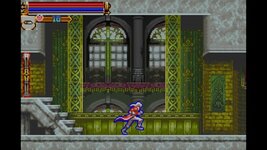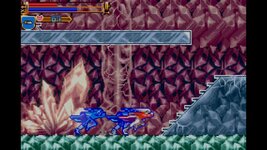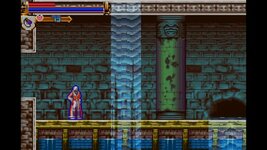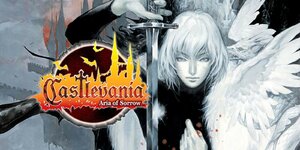With the 3 Castlevania games on the DS having just been made available on current gen systems through a really cool compilation, I thought now was as good a time as any to revisit my old writeup of the Castlevania Advance Collection, which did for the GBA Castlevanias what Dominus Collection does for the DS games. Like all my writeups, this was originally posted on the Fediverse, and amusingly enough, my buddy Rasterman was also playing through these games at the same time and posting his own impressions, so we got a rare case of dueling writeups. And with that out of the way, let's get to the actual games:
Circle of the Moon
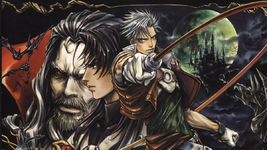
Hey, so you know how in 1995, two separate live-action movies starring talking pigs were released? This is kinda like that, only involving Fedi writeups about GBA Castlevania games coming out the same week. Will this writeup be a Gordy or a Babe? You be the judge.
Anyway, thanks to Rasterman for reminding me that the Castlevania Advance Collection exists, it was one of those games that I was interested in, but didn’t end up buying when it first came out. I’d already played Circle of the Moon to completion on the GBA, but I never finished Harmony of Dissonance on the Wii U, and Aria of Sorrow I never played at all, so it still seemed like good value. Also, I wouldn’t mind revisiting Circle of the Moon anyway.
So far I’ve finished CotM and HoD, so let me go over those two games in order. Circle of the Moon was surprisingly nostalgic for me, I say surprisingly because the criminally underappreciated N64 Castlevania games have always loomed much larger in my memory, but replaying CotM for the first time in over 20 years, I found myself repeatedly remembering how I felt playing it for the first time: My reaction to the beautiful, yet creepy choir song that’s the main menu theme (I was impressed by the GBA having improved so much over the GBC in terms of audio), to seeing early-game areas later on suddenly becoming populated with legitimately strong enemies, and of course, the ridiculous amounts of newfound freedom that comes with the Roc Wing, and how it felt leaping hundreds of feet up in the air to the remix of The Sinking Old Sanctuary. Stuff like the opening revival and summoning of Dracula (complete with Camilla simping hard for Vlad), Hugh going Full Sasuke, the brutal challenge rooms, and having to fly high up in the air to avoid the devastating attacks of the final boss had also dug themselves deep into my memory.
As for the game itself, it’s a post-SotN 2D Castlevania game, so of course it’s one of those Metroidvania games that helped popularize the genre and justify the “vania” part of the name. Thinking about it, CotM must have been the first Metroidvania I ever played (it was my first 2D Castlevania, while Fusion was my first Metroid, and that came out after CotM), and I certainly remember finding the concept of a non-top down 2D adventure game that’s set in one big world intriguing.
Even today, it’s clearly a very solid Metroidvania, where you start out very slow and weak, but quickly start making serious progress and opening up more and more of Dracula’s castle. The primitive RPG elements are a good fit for a Metroidvania, making you feel you’re constantly making at least *some* progress even as you’re just running around killing enemies, and the chance that enemies will drop rare loot once in a blue moon further makes fighting them feel worthwhile. There are also plenty of secrets, even lots of breakable walls hiding useful upgrades.
I never really had a problem with being stuck in CotM, the map makes it easy enough to see where the sections that will lead you further into the castle are, so whenever you get a new ability it will be easy enough to locate relevant previously blocked-off passageways. Making the time spent exploring all the more enjoyable is the wonderful soundtrack, which reminds you of why the Castlevania series is so renowned for its fantastic music (for many people, the most exciting part about Simon and Richter being added to Smash Bros. was all the Castlevania music that accompanied them).
The classic Castlevania mix of whipping and flinging various subweapons at your enemies works well, but the more sophisticated enemies require decent spacing and timing to handle, and the game is on the challenging side, which of course is no bad thing. Hell, the great variety of enemies that you face become the defining obstacles of the various sections of the castle you visit, which otherwise aren’t all that varied or visually interesting (CotM looked fine for a GBA launch game, but not much more). Different enemies will have to be dealt with in different ways (a nasty Wasp enemy even gave the otherwise dogshit throwing knife subweapon a chance to shine), and later on more and more enemies start inflicting nasty status conditions on you, in a game that’s very stingy with healing items in general.
The bosses are of course a highlight: Big (some of them outright fill the screen), tough and strong, they’ll definitely challenge you, though part of the challenge is the suboptimal controls making it harder than it should to dodge certain attacks. Don’t get me wrong, most of the time the controls work fine, but especially the fact that you can only run by double tapping the d-pad (because apparently Nathan Graves is handicapped and requires a special items to be able to run) can trip you up in the heat of battle. There are also a couple of boss attacks throughout the game that don’t really seem avoidable if the RNG isn’t in your favor, which is definitely annoying, especially given the relative lack of healing items. That said, none of the bosses are outright bullshit, there is a reasonable margin for error allowed, and it’s not like you don’t have powerful tools at your disposal – for starters, the cross subweapon can do absolutely amazing damage with proper spacing, due to how it continually hits enemies in its path.
Another ace up your sleeve is the magic cards that can drop as you kill enemies. Combining cards from the 2 major categories can give you all sorts of different buffs and effects, like improving your stats, having protective weapons circle you or changing your main weapon into a flame sword or a massive hammer. There are a lot of neat and useful effects the cards can have, and apparently there are a whopping 100 different card effects in total – the problem is that getting cards seems largely luck-based, and you’ll probably finish the game without getting many, if most of them, meaning you’ll be missing out on plenty of much-welcome gameplay variety. There is one form of New Game Plus that lets you play the game with all the cards unlocked from the start, but that’s just excessive – making more of the cards available earlier in the regular game, especially the ones that aren’t so much overpowered as just plain fun (like changing your weapon or giving you elemental powers) would have been a better solution.
Circle of the Moon

Hey, so you know how in 1995, two separate live-action movies starring talking pigs were released? This is kinda like that, only involving Fedi writeups about GBA Castlevania games coming out the same week. Will this writeup be a Gordy or a Babe? You be the judge.
Anyway, thanks to Rasterman for reminding me that the Castlevania Advance Collection exists, it was one of those games that I was interested in, but didn’t end up buying when it first came out. I’d already played Circle of the Moon to completion on the GBA, but I never finished Harmony of Dissonance on the Wii U, and Aria of Sorrow I never played at all, so it still seemed like good value. Also, I wouldn’t mind revisiting Circle of the Moon anyway.
So far I’ve finished CotM and HoD, so let me go over those two games in order. Circle of the Moon was surprisingly nostalgic for me, I say surprisingly because the criminally underappreciated N64 Castlevania games have always loomed much larger in my memory, but replaying CotM for the first time in over 20 years, I found myself repeatedly remembering how I felt playing it for the first time: My reaction to the beautiful, yet creepy choir song that’s the main menu theme (I was impressed by the GBA having improved so much over the GBC in terms of audio), to seeing early-game areas later on suddenly becoming populated with legitimately strong enemies, and of course, the ridiculous amounts of newfound freedom that comes with the Roc Wing, and how it felt leaping hundreds of feet up in the air to the remix of The Sinking Old Sanctuary. Stuff like the opening revival and summoning of Dracula (complete with Camilla simping hard for Vlad), Hugh going Full Sasuke, the brutal challenge rooms, and having to fly high up in the air to avoid the devastating attacks of the final boss had also dug themselves deep into my memory.
As for the game itself, it’s a post-SotN 2D Castlevania game, so of course it’s one of those Metroidvania games that helped popularize the genre and justify the “vania” part of the name. Thinking about it, CotM must have been the first Metroidvania I ever played (it was my first 2D Castlevania, while Fusion was my first Metroid, and that came out after CotM), and I certainly remember finding the concept of a non-top down 2D adventure game that’s set in one big world intriguing.
Even today, it’s clearly a very solid Metroidvania, where you start out very slow and weak, but quickly start making serious progress and opening up more and more of Dracula’s castle. The primitive RPG elements are a good fit for a Metroidvania, making you feel you’re constantly making at least *some* progress even as you’re just running around killing enemies, and the chance that enemies will drop rare loot once in a blue moon further makes fighting them feel worthwhile. There are also plenty of secrets, even lots of breakable walls hiding useful upgrades.
I never really had a problem with being stuck in CotM, the map makes it easy enough to see where the sections that will lead you further into the castle are, so whenever you get a new ability it will be easy enough to locate relevant previously blocked-off passageways. Making the time spent exploring all the more enjoyable is the wonderful soundtrack, which reminds you of why the Castlevania series is so renowned for its fantastic music (for many people, the most exciting part about Simon and Richter being added to Smash Bros. was all the Castlevania music that accompanied them).
The classic Castlevania mix of whipping and flinging various subweapons at your enemies works well, but the more sophisticated enemies require decent spacing and timing to handle, and the game is on the challenging side, which of course is no bad thing. Hell, the great variety of enemies that you face become the defining obstacles of the various sections of the castle you visit, which otherwise aren’t all that varied or visually interesting (CotM looked fine for a GBA launch game, but not much more). Different enemies will have to be dealt with in different ways (a nasty Wasp enemy even gave the otherwise dogshit throwing knife subweapon a chance to shine), and later on more and more enemies start inflicting nasty status conditions on you, in a game that’s very stingy with healing items in general.
The bosses are of course a highlight: Big (some of them outright fill the screen), tough and strong, they’ll definitely challenge you, though part of the challenge is the suboptimal controls making it harder than it should to dodge certain attacks. Don’t get me wrong, most of the time the controls work fine, but especially the fact that you can only run by double tapping the d-pad (because apparently Nathan Graves is handicapped and requires a special items to be able to run) can trip you up in the heat of battle. There are also a couple of boss attacks throughout the game that don’t really seem avoidable if the RNG isn’t in your favor, which is definitely annoying, especially given the relative lack of healing items. That said, none of the bosses are outright bullshit, there is a reasonable margin for error allowed, and it’s not like you don’t have powerful tools at your disposal – for starters, the cross subweapon can do absolutely amazing damage with proper spacing, due to how it continually hits enemies in its path.
Another ace up your sleeve is the magic cards that can drop as you kill enemies. Combining cards from the 2 major categories can give you all sorts of different buffs and effects, like improving your stats, having protective weapons circle you or changing your main weapon into a flame sword or a massive hammer. There are a lot of neat and useful effects the cards can have, and apparently there are a whopping 100 different card effects in total – the problem is that getting cards seems largely luck-based, and you’ll probably finish the game without getting many, if most of them, meaning you’ll be missing out on plenty of much-welcome gameplay variety. There is one form of New Game Plus that lets you play the game with all the cards unlocked from the start, but that’s just excessive – making more of the cards available earlier in the regular game, especially the ones that aren’t so much overpowered as just plain fun (like changing your weapon or giving you elemental powers) would have been a better solution.

